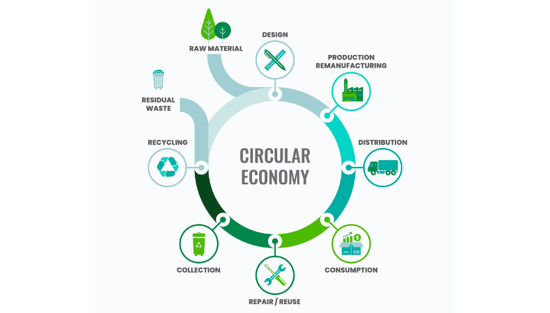12 steps to create your sustainable web-to-print business

FESPA's Head of Associations & Technical Lead shares an insightful step by step guide on how to start a sustainable web-to-print business. This offers a lucrative opportunity for printers and provides personalised solutions in a sustainable way.
The reasons you shouldn’t ignore Web-to-Print in your business
It’s commonly understood that Web-to-print technology leverages the power of the internet to provide customizable printing services. This business model allows customers to design, order, and receive printed products directly through a web shop. The scope of products ranges from personalised apparel and accessories to custom stationery, marketing materials, and more. According to respondents of the FESPA Print Census 2023, 56% of Graphic printers do not intend to develop Web -to-Print over the next 2 years. Considering that Google is the new local, in fact it couldn’t be more local as it sits in the palm of our hands. The decisions of buyers to source from online providers presents the benefits of quick processing across a wide range of products that can be printed. As an example, Printful.com now offers 300 products and increased their sales by 39% between 2020 to 2021 to $281 million. They have achieved this by investing $38 million in printing equipment and technology bringing their overall investment since foundation to $83 million.
As you read through this blog you’ll get an idea of what is involved in developing this business and the proposed market growth over the next few years. Even if you’re not interested in building such a large-scale business there are many opportunities for niche products and their audiences.
Why is Web-to-Print a High-Value Proposition?
Growing Demand for Personalisation: There's an increasing customer demand for personalised products. Web-to-print allows for customisation at scale, meeting this demand effectively. The web-to-print market is forecast to grow by $528.71 million during 2021-2025, progressing at a CAGR of 7.99% during the forecast period (Research and Markets). By 2028, the global print-on-demand software market is expected to grow at a substantial CAGR of 33.5% (Digital Journal).
E-commerce Integration:
The integration of web-to-print services with e-commerce platforms like Shopify, WooCommerce, and BigCommerce simplifies the process of setting up an online store. This is great for market testing with existing providers before transferring to your own production facility.
Automation and Efficiency:
Advanced software like EnFocus Switch among others automates much of the process through API’s, from order receipt to production and shipping, reducing operational costs and improving efficiency.
Low Inventory Risks:
The print-on-demand aspect means products are created as orders come in, significantly reducing inventory risks and storage costs. There is a well-established next day supply chain for many ‘blank’ products to be personalised.
Sustainability:
With growing awareness around environmental issues, web-to-print businesses can capitalise on this change by offering more sustainable and eco-friendly printing options.
Wide Customer Reach:
The online nature of the business allows for a global customer base, unlike traditional brick-and-mortar stores.
Identifying the Market and Competitive Landscape
Before racing ahead, it's critical to understand the market you are looking to serve. The presence of giants like Amazon Merch, Printful, and Vistaprint means that distinguishing your offer is vital. This can be achieved by targeting niche markets such as eco-friendly products, local pride, specific hobbies, or cultural merchandise. Understanding customer needs in these niches and developing a unique value proposition (UVP) is the start.
A Step-by-Step Guide to Starting a Sustainable Web-to-Print Business
Step 1: Market Research and Niche Identification
Conduct thorough market research to identify a lucrative niche. Assess customer needs, market trends, and the competitive landscape.
Step 2: Business Planning and Financial Analysis
Develop a comprehensive business plan, including financial projections. This step involves assessing start-up costs, pricing strategy, revenue models, and securing funding if necessary. Be aware that the process of building your system will require considerable resources and the return-on-investment timeline needs to be understood to manage cash-flow.
Step 3: Choosing an E-commerce Platform
Select an e-commerce platform that aligns with your business needs. Consider factors like scalability, user-friendliness, and sustainability features.
Step 4: Integrating Sustainable Practices
Incorporate sustainable practices in material sourcing, production, packaging, and shipping. This includes using eco-friendly materials, reducing waste, and partnering with suppliers adhering to sustainable practices. Ensure that you market how you have reduced impacts from the production side, low energy printers, renewable energy, zero emissions of hazardous chemicals to aquatic and airborne environments. There are many areas that show customers your concern and care but ensure the benefits are science based. This applies if you’re working with a partner or through your own production site.
Step 5: Testing the Market with Established Suppliers
Start with established print-on-demand suppliers to understand market demand and refine your product offerings without significant initial investment. Whilst there is set up time involved, and the margins limited it will give vital insight.
Step 6: Building a Brand and Marketing
Develop a strong brand identity and implement a strategic marketing plan. Focus on digital marketing channels to reach your target audience. Many of the established Print-on-Demand suppliers are focussed on targeting micro-brands via TikTok and Instagram who are focussed on a side-hustle or building a brand.
Step 7: Legal Considerations and Usage Rights
Ensure compliance with copyright laws, especially when dealing with customer-generated designs. Develop a clear policy for managing usage rights. You may be surprised by some of the ideas customers want you to print! It is very important to be clear that defamatory images or messages fall beyond your terms and conditions.
Step 8: Setting Up Customer Service and Experience
Establish efficient customer service protocols, focusing on responsiveness and customer satisfaction. Implement an order approval preview feature to minimize returns. Build a product workflow and get a variety of colleagues to test it so that it can refined.
Step 9: Transition to Own Production (If Viable)
Evaluate the feasibility of setting up your own production facility for greater control and profit margins. This step involves significant investment and operational expertise.
Step 10: Operational Efficiency and Automation
Invest in software solutions for efficient order processing, inventory management, and customer relationship management.
Step 11: Scaling the Business
Regularly assess business performance and market trends. Be prepared to adapt and scale your product range and production capacity.
Step 12: Sustainability Reporting and Improvement
Regularly measure and report on your environmental impact. Strive for continuous improvement in sustainability practices.
Conclusion
The web-to-print business model represents a lucrative opportunity in the digital age, offering personalised solutions in a sustainable and efficient manner. By following the outlined steps, entrepreneurs can navigate the complexities of this market and establish a successful, sustainable web-to-print business. The key to success lies in understanding customer needs, leveraging technology, and committing to sustainable practices. With careful planning and execution, a web-to-print business not only stands to gain financially but also contributes positively to the global push for environmental sustainability.
Topics
Recent news

Green Printing: how Sustainability drives business success
Nessan Cleary shares sustainable printing benefits businesses and the environment. Auditing suppliers and using eco-friendly materials are crucial. Optimising production with energy-efficient equipment and minimising waste reduces costs. Proper waste disposal and premises efficiency further lower the carbon footprint. Staff training and customer recycling solutions complete the sustainable approach.

Sustainability and keeping the faith
Laurel Brunner discusses how the printing industry has drastically reduced its environmental impact through technological advances, despite lingering perceptions of paper waste. While consumer habits pose a challenge, the industry continues to pursue greener practices.

Kyocera wins Anthem Award for Sustainability, Environment and Climate
Laurel Brunner shares how Kyocera, a Japanese manufacturer of digital printing system was awarded a silver award for its green skills report on "A Green Edge: Green Skills for the Future".

How to design for a circular economy in a linear world
Laurel Brunner explains the challenges for businesses to prioritise circular economy when economies have evolved to be linear. Laurel shares examples of different businesses who are designing products that can suppor the circular economy. These include The Ellen MacArthur Foundation, DS Smith and Vilsund Blue A/S.